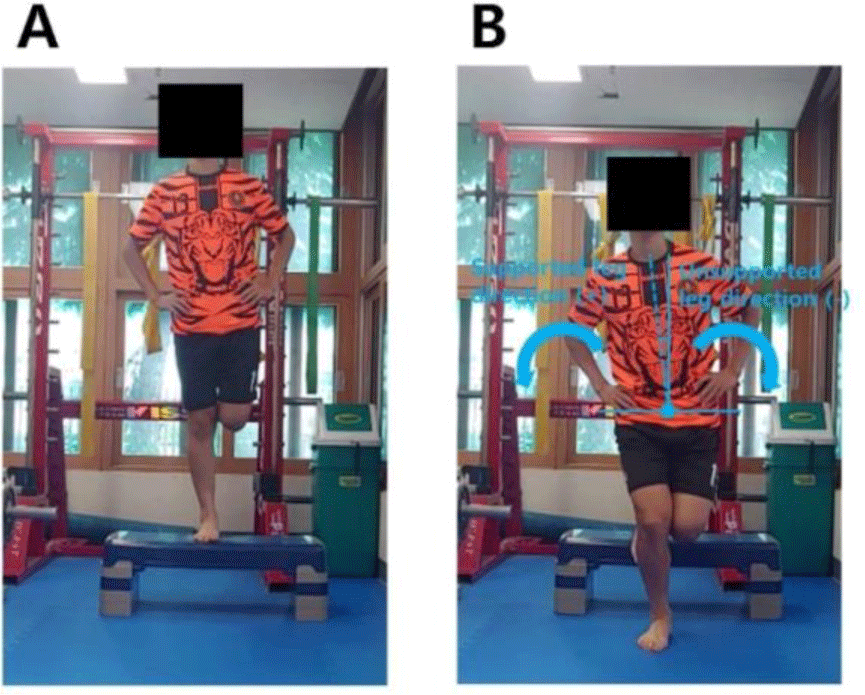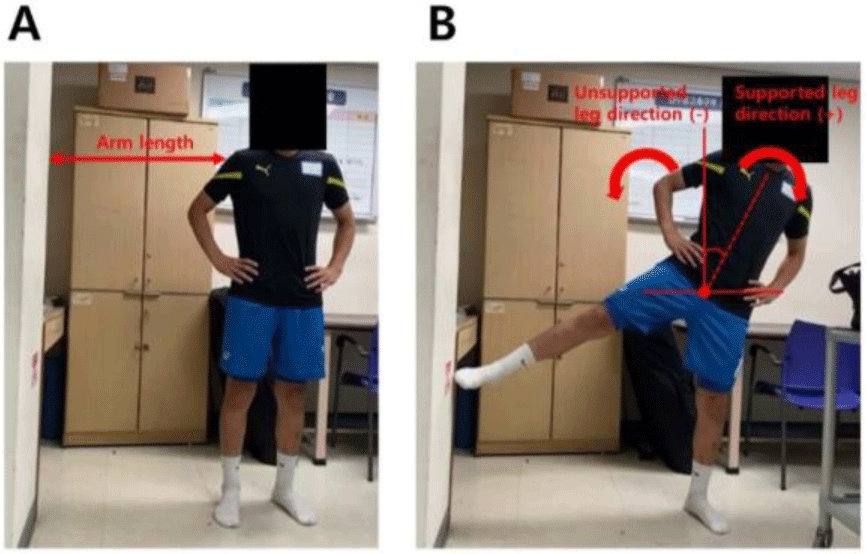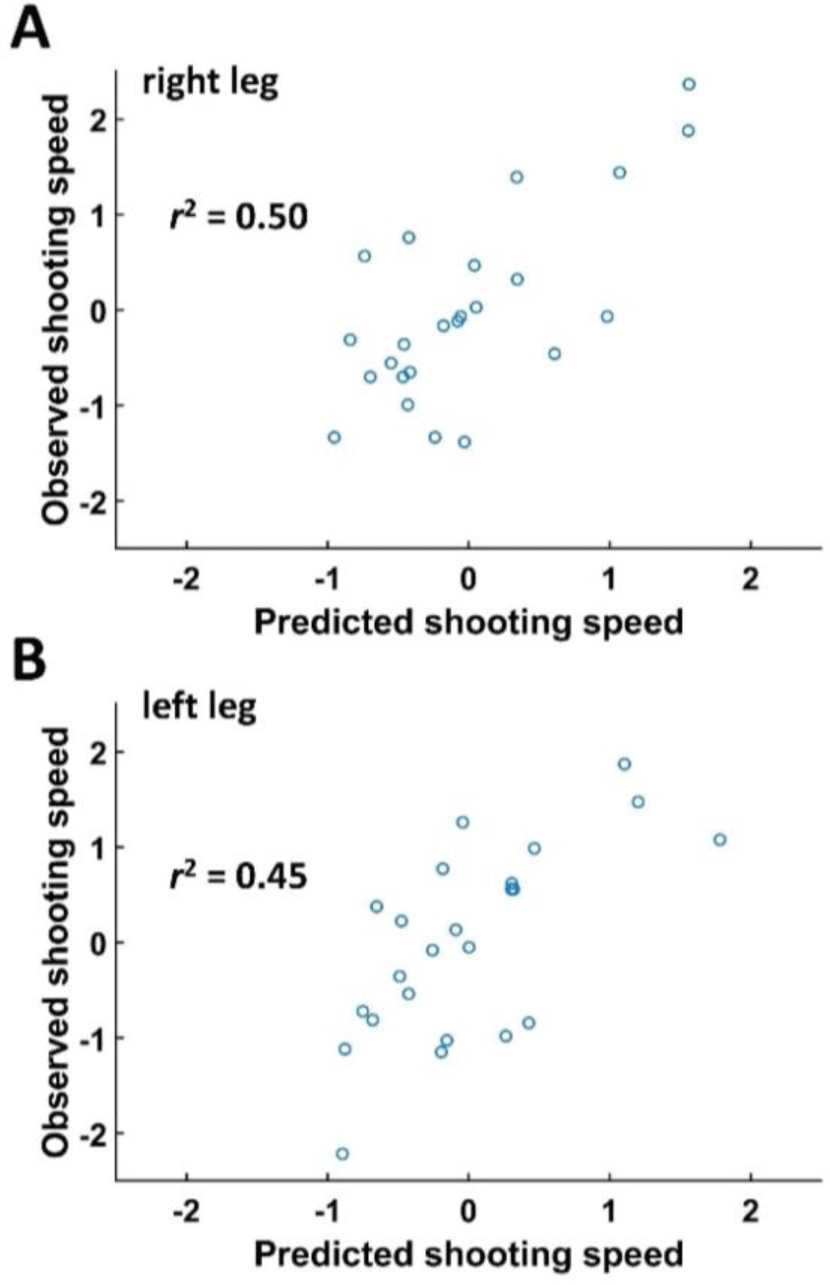INTRODUCTION
Shooting skills are important in soccer because the objective of the game is to score more goals. Among skills, shooting speed is a crucial element of shooting. As shooting speed increases, the likelihood that the opponent’s goalkeeper will fail to block the ball decreases, thereby increasing the probability of scoring a goal. To achieve high shooting speed, the kicking leg must be swung rapidly, and the ball must be contacted precisely while the other leg supports the body.1 Therefore, it is difficult to achieve shooting proficiency. However, the factors influencing shooting speed have rarely been investigated.
The one-leg drop landing exercise is relevant to shooting speed because both shooting and one-leg drop landing are single-leg dominant movements. According to Bozkurt and Kucuk,2 shooting speed is associated with the muscle power of the supporting leg. Similarly, during the landing phase of the drop landing exercise, the muscles of the supporting leg decrease downward movement of the body under large loads to maintain balance.3,4 If the coordination and strength of those muscles are insufficient, a ligament-dominant strategy may be adopted, where passive structures are forced to absorb the load.5-7 This strategy, however, results in excessive strain on the ligaments. Such repetitive strain, inherent to a ligament-dominant approach, significantly heightens the risk of ligament injuries. A high knee valgus angle is one such change, commonly associated with the adoption of the ligament-dominant strategy.8 The knee valgus angle reflects the ability of the supporting leg to control the body in response to a large ground reaction force.
Lateral trunk tilt during standing hip abduction is important to maintain balance under unstable conditions.9,10 During standing hip abduction, the center of mass moves towards the non-supporting leg.11 To maintain body balance, the trunk leans away from the abducted leg; this movement would depend on muscle strength of the supporting leg.12 When the trunk leans toward the supporting leg, the abducted leg can move more efficiently. Measurement of the trunk angle in the frontal plane during standing hip abduction should provide useful information regarding the trunk position required for efficient movement of the non-supporting leg.
Analyses of joint angles using two-dimensional (2D) cameras are advantageous in terms of equipment costs and the time required to collect and analyze data.13,14 Moreover, 2D joint angle measurements are valid and reliable. Previous studies showed that 2D cameras are useful for analyzing individuals who exhibit high knee valgus angles during the performance of weight-bearing tasks.13-16 However, 2D cameras are not ideal for analyses of the knee valgus angle with hip and tibial rotation. In side-step and side-jump tasks, the mean knee valgus angle measured using 2D cameras was not strongly correlated with the angle measured using a three-dimensional system (r2=0.58–0.64).17 Despite this limitation, joint angles can be accurately measured in the frontal plane using 2D cameras when rotation is minimal. An example of such movement within the frontal plane is trunk tilt. Additionally, trunk tilt towards the supporting leg is associated with the knee valgus angle during weight-bearing exercises. Previous studies reported that the peak knee abduction moment is correlated with trunk lateral tilt angle.18-20 Moreover, providing landing instruction to decrease trunk lateral motion has been shown to significantly reduce knee abduction angle in the frontal plane.21-24 Because trunk abduction is associated with less rotation during landing when compared with the knee valgus angle, lateral trunk tilt is more amenable to measurement using a 2D camera during landing. Therefore, in a 2D camera system, measuring lateral trunk tilt can be an alternative way to determine if a ligament-dominant strategy is being used during a drop landing task, rather than relying solely on knee valgus angle.
If the trunk angles during one-leg drop landing and standing hip abduction exercises are related to shooting speed, this crucial soccer skill could be evaluated without the need for expensive measurement and analysis equipment. The aim of this study was to determine whether trunk angles in the frontal plane during one-leg drop landing and standing hip abduction exercises can predict shooting speed. It was hypothesized that the trunk angles during both exercises would show a relationship with shooting speed.
METHODS
A sample size for a two-tailed hypothesis was calculated using GPower software (version 3.0.10). A minimum of 21 participants would be required, with a statistical power of 80% and a significance level of p<0.05. Twenty-four elite high school soccer players aged 17.0±0.8 years (mean height, 175.4±4.0 cm; mean weight, 68.2±5.9 kg) participated in this study. All participants were members of the elite high school soccer team, which is registered with the National Football Association. The mean daily exercise duration of the participants was 135.2±37.9 min. Individuals with vestibular, neurological, cardiopulmonary, psychological, or musculoskeletal disorders were excluded. The study protocol was approved by the Institutional Review Board of University, and all participants provided written informed consent.
In this study, the procedures, including the one-leg drop landing task, standing hip abduction task, and shooting, were performed over two days, with the order of tasks being randomized. Some participants completed the shooting and drop-landing tasks on the first day and the standing hip abduction task on the second day, while others performed the standing hip abduction task and shooting on the first day, and the drop landing task on the second day. This randomized approach ensured a balanced evaluation of each participant’s abilities in varied conditions.
We utilized the Samsung Galaxy S8 smartphone (Samsung, Seoul, South Kore) for recording both the one-leg drop landing and standing hip abduction tasks. The Galaxy S8 is equipped with a built-in camera capable of recording in up to 30 frames per second (FPS) and in 1080P resolution. For our purposes, the default camera application installed on the device was used. The camera was positioned at the height of the participant’s pelvis to focus on the pelvic area and ensure full-body visibility. The recording was done at a standard zoom level of 1.0X. This setup provided a consistent and reliable method for capturing and analyzing the movements during the tasks. The myKicks app (Formalytics, Perth, Australia) was used for measuring shooting speed in the shooting task.
All participants wore their own soccer kits during the one-leg drop landing exercise. First, they completed a 15-min warm-up involving treadmill walking at a self-selected speed. After the participants received an explanation of the drop landing protocol, they practiced the task until they became accustomed to the drop landing height. Participants were instructed to drop down from a 40-cm box without jumping or losing their balance. The starting position of the drop landing task was a standing position with the toes of the supporting leg pointing forward; the hands were kept on the waist, and the non-supporting leg was flexed at the knee at an angle of 90° (Figure 1A). When the participants had familiarized themselves with the one-leg drop landing task, they performed it in bare feet using the right and left legs. Three drop landings were performed for both legs in a random order. A rest period of one minute was provided between each drop landing task. Additional rest time was also provided if participants requested more recovery time. If a participant did not follow the task instructions or lost their balance, or if their non-weight-bearing leg contacted the ground, the participant was asked to perform the task again. The camera of a mobile phone (Galaxy S8; Samsung, Seoul, South Korea) was used to record the exercises.

The starting position for the standing hip abduction exercise was an upright stance, with the legs and arms kept straight while looking straight ahead. Participants were asked to stand one arm length away from the wall (Figure 2A); they then abducted one leg until the foot touched the wall (Figure 2B). If the participant’s hips rotated externally or their balance was lost, the task was repeated. Participants performed the task for both the right and left legs. The order in which each leg was exercised was randomized. A rest period of 30 seconds was allowed between tasks to ensure adequate recovery. The camera of the Galaxy S8 device was used again to record all exercises.

Shooting speed tests were conducted outdoors on a soccer practice pitch. After a 10-min warm-up including stretching exercises and walking or jogging at a self-selected speed, participants performed penalty kicks three times with each leg. The order of kicking with the right or left foot was randomized. The target was the high central part of the goal. Participants were instructed to kick the ball with maximum force. Before the test, one practice kick was performed for each leg. The time between each shot was > 10 s. If the ball missed the high central part of the goal, the attempt was considered a failure and the participant was asked to perform another penalty kick. Shooting speed was measured using the myKicks app.
Trunk angles during drop landing and hip abduction were obtained using Kinovea software (ver. 0.9.5; Kinovea, Bordeaux, France). During drop landing, the trunk angle was measured in the frontal plane when the head was at its lowest point. A trunk angle of 0° represents a fully upright position. When the trunk leans towards the weight-bearing leg, the trunk angle is positive. For example, when the trunk leans towards the right side during right-leg drop landing, the trunk angle is between 0 and 90°. Conversely, when the trunk leans towards the left side, the trunk angle is between 0 and –90° (Figure 1B). Lateral tilt increases with the trunk angle. During the standing hip abduction test, the trunk angle was measured with the foot in contact with the wall (Figure 2B). Similar to the drop landing exercise, 0° represents a fully upright position during hip abduction, and the trunk angle increases with lateral trunk tilt.
As stated above, each participant performed three drop landing, standing hip abduction, and penalty kick trials for each leg. Standardization was used to eliminate scale differences between participants,25 as follows:
where xi scaled and xi are the scaled and unscaled variables for each participant, respectively; x̅ is the mean value of a specific variable for all participants; and σi is the variance in that variable. Scaled variables were used for statistical analysis.
Multiple linear regression models were also constructed using the Enter method, where all predictor variables for trunk angles during same-side one-leg drop landing and opposite-side standing hip abduction tasks were included at once to determine their predictive power on shooting speed for the right and left legs. All statistical analyses were performed using MATLAB software (ver. 2022a; MathWorks, Natick, MA, USA). Linear regression models were fitted to the observed data using the ‘fitlm’ MATLAB function. P-values < 0.05 were considered statistically significant.
RESULTS
The mean right and left leg shooting speeds were 92.3± 8.0 and 85.5±10.8 km/h, respectively (Table 1). The mean trunk angles were 4.56±6.16° and 6.83±4.49° for the right- and left-sided one-leg drop landing exercises, respectively (Table 2). In the standing hip abduction test, the mean trunk angles were 14.00±6.02° and 13.66±5.48° on the right and left sides, respectively (Table 2).
| One-leg drop landing | Standing hip abduction | |||
|---|---|---|---|---|
| Right | Left | Right | Left | |
| Trunk angles (°) | 4.56±6.16 | 6.83±4.49 | 14.00±6.02 | 13.66±5.48 |
In the linear regression analysis, trunk angles during the left-sided one-leg drop landing and right-sided standing hip abduction tasks were significantly associated with the right-sided shooting speed (r2=0.50, p<0.001; Figure 3A and Table 2), and those during the right-sided one-leg drop landing and the left-sided standing hip abduction tasks were significantly associated with the left-sided shooting speed (r2=0.45, p<0.01; Figure 3B and Table 3).

DISCUSSION
We investigated the relationship between shooting speed and trunk angles during one-leg drop landing and standing hip abduction functional movement tasks. In both tasks, the trunk angle was measured in the frontal plane using a 2D camera. For the drop landing task, the trunk angle was measured at the lowest point of the head, while for the standing hip abduction task, it was measured at the point of hip abduction hip abduction equivalent to one arm’s length. Those measured trunk angles during opposite-side drop landing and same-side standing hip abduction explained 45%–50% of the variance in shooting speed for each side. Research focusing on factors influencing soccer shooting has been relatively scarce. Therefore, the findings make a significant contribution by identifying meaningful correlations between trunk angles in functional movement tasks and shooting speed, offering new insights into biomechanical factors that can enhance soccer performance.
In the linear models, the coefficients of trunk angle during drop landing were negative (Table 3). That is, lateral trunk tilt towards the supporting leg during the one-leg drop landing exercise decreased with increasing shooting speed. This suggests that the ability to maintain the trunk in a neutral position is related to shooting speed. To prevent lateral trunk tilt, the hip abductors, extensor muscles, and muscles surrounding the trunk should be controlled.26 Overall, our results support the findings in a previous study, which showed that balance is associated with shooting ability.27
Lateral trunk tilt during one-leg drop landing is associated with knee abduction. Lateral trunk tilt towards the supporting leg increases with the peak knee abduction moment during weight-bearing functional tasks, such as landing and cutting.20,22,24 An increased peak knee abduction moment suggests the use of a ligament-dominant strategy, indicative of a lack of control in the muscles of the supporting leg forces.7,8,28 Therefore, our result, showing that smaller trunk angles are correlated with higher shooting speeds, implies that the ability to effectively control the muscles of the supporting leg is crucial for achieving higher shooting speeds. This finding highlights the importance of muscular control over ligament reliance in the context of athletic performance.
In the standing hip abduction task, the trunk tended to lean towards the supporting leg as the shooting speed increased, as evidenced by the coefficients of the trunk angle in both linear models. Hip abduction requires activation of the gluteus medius.29 However, our standing hip abduction task did not require high gluteus medius strength on both sides to abduct the hip by an amount equivalent to one arm length.30 We used this task to evaluate the ability of each participant to control the muscles of the supporting leg under unstable conditions, as determined by measurements of lateral trunk tilt. During hip abduction, the center of mass moves toward the non-supporting leg. Lateral trunk tilt toward the supporting leg may help maintain the center of mass and prevent falling, regardless of lumbopelvic segment activation.31-33 Participants who exhibited greater lateral trunk tilt toward the supporting leg were better able to control the trunk position. Because shooting is executed while the body is in an unbalanced position, the ability to control the trunk is important for the maintenance of an optimal kicking leg position and achievement of high shooting speed.
The one-leg drop landing and standing hip abduction tasks were similar to the shooting movement in that the one-leg drop landing task requires weight-bearing on the supporting leg and the standing hip abduction task is performed under unstable conditions. Those tasks in the present study evaluated the musculature capacity of the supporting leg and the ability to control trunk during unsupported leg movement by measuring trunk angle in the frontal plane. Although 2D cameras have some limitations, we successfully measured trunk angles in the frontal plane using the built-in camera of a mobile device during one-leg drop landing and standing hip abduction exercises. In our findings, the trunk angles measured by 2D cameras during those simple functional movement tasks can explain shooting speed. The results suggest that the joint angles measured by 2D cameras during simple weight-bearing tasks can be used to predict shooting speed.
While providing insightful observations, our study is not without limitations. The primary constraint lies in the use of 2D cameras for the measurement of trunk angles. Although 2D imaging offers ease of use and accessibility, it inherently lacks the depth perception and accuracy of three-dimensional (3D) analysis. This may lead to potential inaccuracies in capturing complex joint movements, especially where rotation or multi-planar motions are involved. Additionally, the reliance on mobile device cameras, despite their convenience, might not offer the precision of dedicated biomechanical measurement tools. These limitations must be considered when interpreting our results, as they could influence the accuracy of the trunk angle measurements. Future studies could benefit from incorporating 3D motion analysis to validate and extend our findings.
CONCLUSIONS
A moderate proportion of the variance in shooting speed was explained by trunk angles in the frontal plane measured during one-leg drop landing and standing hip abduction tasks. When the trunk is upright during the drop landing task and leaning towards the supported leg during the standing hip abduction, shooting speed increases. This finding suggests that the ability to control the muscles of the supporting leg during weight-bearing, and the trunk position during movement of the non-supporting leg under unstable conditions, are important determinants of shooting speed. Furthermore, the findings of this study may have practical implications for coaches and athletes who aim to enhance the shooting performance through targeted training.







